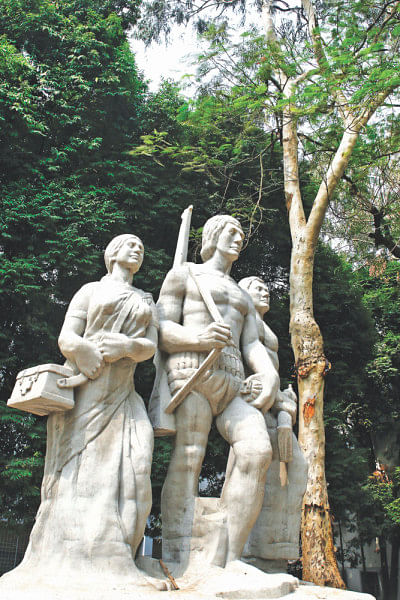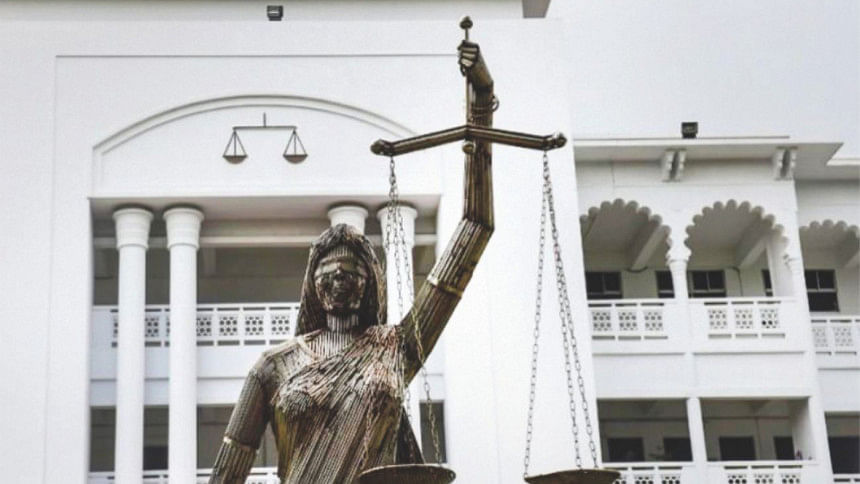What do public sculptures speak of?

“Memory takes root in the concrete, in spaces, gestures, images, and objects; history binds itself strictly to temporal continuities, to progressionsand to relations between things.” — Pierre Nova, Between History and Memory: Les Lieux de Mémoire

In May of 2017, the statue of a saree-clad, blind-folded Lady Justice was pulled down from the Supreme Court premises and moved to an annex building due to pressure from the religious group, Hefazat-e-Islam. The incident brought to notice various issues and highlighted the active role public art plays in national discourse. It is of importance, then, to understand how this role comes into being.
Public art plays an active role in nation-building. Sculptures or murals placed at major roundabouts, university campuses, and government premises, are in a strategic view-point where the art is visible to maximum spectators. Thereby, these structures are in a dialogue with public thought. They speak to the spectators through representation—they either represent events, histories, or identities. Sculptures in public view pertaining to historical significance reflect and impact the public's perception of history and identity.
Public Art and Memory
When we talk about collective memory, we do not mean to say “history”. History is constructed through objective truths that are independent of personal and psychological bias. Memory, on the other hand, is a social process. It works through a framework of spectatorship such as encountering mass media, tourist sites, and family traditions, and it is created by social groups such as artists, governments, and family members. Following this concept, public sculptures can be understood as a tool for creating this sort of collective memory. They provide us with an interpretation of history rather than history itself.
This process of interpreting history works in two-ways: remembering and forgetting. The two have a dialectical relationship with each other. Meaning, sculptures that remember an event also at the same time choose to forget another. For example, if a sculpture is only depicting a war hero, it chooses to make a war heroine invisible. This complicated relationship between visibility and invisibility is why we must pay close attention to our sculptures in order to understand which part of history is made available to the public and which parts are not. As French Historian Pierre Nova wrote in his seminal essay Between History and Memory: Les Lieux de Mémoire, “we speak so much of memory because there is so little left of it”.

Memory and Beginning of History
Dhaka's history on more occasions than one is produced as an isolated narrative detached from the greater history of the subcontinent. There are barely sculptures engaging with themes of anti-colonialism and Partition. Colonial era buildings and establishments are accepted either with absolute denial of colonial legacy, or with open-armed glorification of the British Raj.
Consider the sculpture at Mirpur's ECB Square called 100 Years of Dhaka Monument by Nreepaul Khan in 2012. As the name suggests, the sculpture honours Dhaka's glorious history. It's a wide concrete spiral illustrating Tom-Toms (horse-carts), Smriti Shoudho, Lalbagh Kella, Shahid Minar and other heritage sites and objects related to either Nawab-reigned Dhaka or post-independence Dhaka. The sculpture chooses to remember the legacy of the Nawabs but it simultaneously takes part in forgetting British colonialism which coexisted with the Nawab regime. While it remembers European presence by depicting the Pogose School, Portuguese Church, and Greek Church, the only mention of colonisation is through perhaps Curzon Hall—which is also glorified.
Erasing anti-colonial resistance from Dhaka's history gives space to misconstrued and misinformed national identities. It makes the city appear immune from famines, wars, land reforms, and communalism that did in fact take place on this soil. Furthermore, it hampers our ability to put things in perspective, as with religious identities and communalism, for example. Cosmopolitan memory has the capacity to make or break nationalist political communities and sculptures that memorialise history.

The Women Question
Even though there is no dispute about the importance of the Language Movement and Liberation War in the nation's history but the sculptures memorialising them contain representational bias. These sculptures often [mis]represent women's involvement in both instances as passive participants. Rezwana Karim Snigdha, Associate Professor of Anthropology at Jahangirnagar University, states in her paper entitled “Gender Representation of Post-War Public sculptures in Dhaka City,” that “representation is a discursive practice of the dominating class and through this practice it creates some form of new knowledge which makes the public discourse.”
The famous Liberation War sculpture Aparajeyo Bangla in the Dhaka University campus, for example, depicts bravery and leadership in the two male figures while the calm and graceful female figure carries a first-aid kid. The image of the woman in this scenario is restricted to the role of a caregiver and nourisher. This trope is repeated in Shamim Sikder's Bijoy Ullash, also in Dhaka University, where a dove rests upon the female figure's shoulder personifying the woman as peace. In Mrinal Haque's Jononi o Gorbito Bornomala at Paribagh, the woman is seen to be in despair, carrying her martyred son.
While these sculptures acknowledge women's presence during major historical events, they only do so within the roles of a mother or caregiver. These sculptures construct a gender role for women as emotional carriers, erasing those women who were actively performing roles of leaders. Women such as Pratibha Matsuddi, Halima Khatun, and Laila Parveen Banu are notable heroes of the liberation and language movement but their participation is neglected in these tropes. The sculptures provide a partial history, and thus, create a public memory of what women can embody during national struggle.
Sculptures and Unspeakability
The overreaching narrative of a majority of public sculptures enforces a middle-class Bengali identity. So far, we have managed to critique representations in existing sculptures but how do we critique representations that do not even exist? The only way to remember identities that do not adhere to the dominant one is by observing a culture of absence that surround them.
For instance, there is not a single sculpture depicting indigenous art or done by an indigenous artist—even on university campuses which we might consider as more progressive areas of the city. By erasing marginalised identities, sculptures are actively playing a part in re-enacting a Bengali identity that harnesses entitlement and ownership over cultural capital produced on this land.
Moreover, the Bengali identity promoted in national discourse is not even accessible to everyone in the class and caste spectrum. None of the sculptures, for example, depict conditions of agrarian class even though Bangladesh's folk heritage and economy depend heavily on the likes of farmers and fishermen. Even Liberation War sculptures barely depict the rural classes' involvement. They are virtually invisible in the nation's struggle for self-determination.
Public sculptures also neglect the urban working class even though they have been an important aspect of national discourse. Lives lost in factory fires and industrial hazards are not memorialised the way war heroes are. In 2015, on the second anniversary of Rana Plaza building collapse, a sculpture was erected honouring the fallen which is the only one of its kind. It is evident that martyrdom is reserved along class lines. While middle-class Bengalis are memorialised, working class Bengalis are considered collateral damage.

Who is responsible for what's on display?
Much like a gallery, public art around Dhaka city gets curated as well. DCC's Beautification Committee identifies the sites which may benefit from a new beautification project and then sends out open calls for tenders. Sculptors and architects then apply for this project to be approved by the DCC. Even though sculptors and architects do have artistic freedom to design their project applications, the ultimate decision rests with the DCC.
Occasionally, artists can independently submit proposals for a new project. Sculptor Mrinal Haque, who is responsible for constructing a majority of the public sculptures around Dhaka city, says that many of his projects were a result of personal initiatives while others were results of tender applications. Sculptures such as Rajoshik at Mintu Road and Jononi o Gorbito Bornomala at Paribagh were erected entirely at Haque's own costs. Sculptors working independently in public spaces still need to apply and receive approval from the DCC which takes about 1-2 years of bureaucratic processing. The sculptures are usually financed through corporate sponsorship where the company can place an advertisement underneath the sculpture. After the costs are covered, the sculptor no longer has ownership of the sculpture and the maintenance responsibility falls under the DCC's jurisdiction which can then choose to renew the corporation's lease for maintenance.
Therefore, it is apparent that the DCC has an absolute authority in what goes up in the city and so, also dictates which parts of history remains in public memory. As such, only the memory which benefits the current government is then remembered.
This follows Pierre Nova's framework that memory is constructed as a social process determined by a group of people (i.e. the government, the city corporation) in a delimited space (i.e. the nation, the city). As one would notice, the content of public art pertains to politics of nationalism and patriarchy and is answerable to the dominant class structure. The ultimate power of what these sculptures can talk about, lies with the people in power and what our collective memory remembers or forgets feeds into what benefits the people who rule over us.
References
Pierre Nova, “Between Memory and History: Les Lieux de Mémoire,” Representations, No. 26, Special Issue: Memory and Counter-Memory. (Spring, 1989), pp. 7-24.
Rezwana Karim Snigdha, “The Gender Representation of post- war public sculptures in Dhaka city: An Observation.”

 For all latest news, follow The Daily Star's Google News channel.
For all latest news, follow The Daily Star's Google News channel. 



Comments